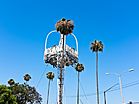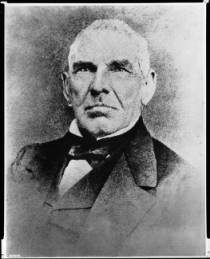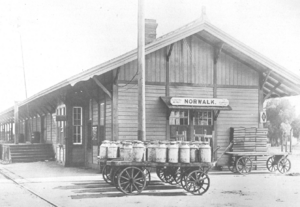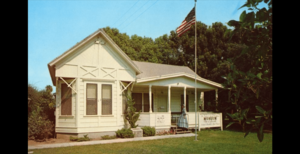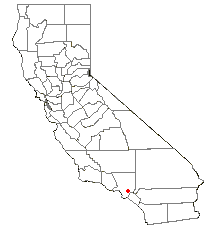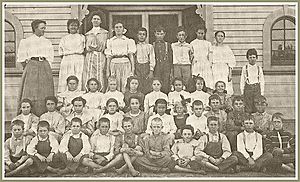Norwalk, California facts for kids
Quick facts for kids
Norwalk, California
|
|||||
|---|---|---|---|---|---|
|
From left to right: Norwalk Town Square sign, Norwalk City Hall
|
|||||
|
|||||
| Motto(s):
"A Connected Community"
|
|||||
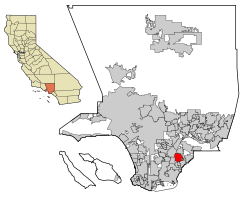
Location of Norwalk in Los Angeles County, California
|
|||||
| Country | |||||
| State | |||||
| County | Los Angeles | ||||
| Incorporated | August 26, 1957 | ||||
| Government | |||||
| • Type | Council/Manager | ||||
| Area | |||||
| • Total | 9.75 sq mi (25.24 km2) | ||||
| • Land | 9.71 sq mi (25.14 km2) | ||||
| • Water | 0.04 sq mi (0.10 km2) 0.40% | ||||
| Elevation | 92 ft (28 m) | ||||
| Population
(2020)
|
|||||
| • Total | 102,773 | ||||
| • Rank | 14th in Los Angeles County 77th in California 335th in the United States |
||||
| • Density | 10,541/sq mi (4,071.8/km2) | ||||
| Time zone | UTC−8 (Pacific) | ||||
| • Summer (DST) | UTC−7 (PDT) | ||||
| ZIP codes |
90650–90652, 90659
|
||||
| Area code(s) | 562 | ||||
| FIPS code | 06-52526 | ||||
| GNIS feature IDs | 1661123, 2411281 | ||||
Norwalk is a city in Los Angeles County, California, United States. In 2020, about 102,773 people lived there.
Norwalk was founded in the late 1800s. It became an official city in 1957. The city is located about 17 miles (27 km) southeast of downtown Los Angeles. It is part of the larger Greater Los Angeles area.
Norwalk is also a member of the Gateway Cities Council of Governments, which is a group of cities in southeastern Los Angeles County. Norwalk has "sister cities" in Mexico: Morelia and Hermosillo.
Contents
History of Norwalk
The land where Norwalk is now was first home to the Shoshonean Native American tribe. They gathered food like honey, berries, acorns, and hunted small animals. Their homes were part of the Sejat Indian village.
In the late 1700s, Spanish settlers arrived. The famous El Camino Real trail, a historic road, passed through the area. In 1784, a Spanish soldier named Manuel Nieto received a large land grant that included Norwalk.
After the Mexican–American War in 1848, the land was divided and sold. This happened when California became part of the United States. Two brothers, Atwood and Gilbert Sproul, heard about the fertile land. In 1869, Atwood Sproul bought 463 acres (1.87 km2) of land. This area was known as Corazón de los Valles, meaning "Heart of the Valleys."
By 1873, railroads were being built. The Sproul brothers gave 23 acres (93,000 m2) of land for a train stop. They made sure the deed said there had to be a "passenger stop." Just three days after the Anaheim Branch Railroad crossed the "North-walk" area, Gilbert Sproul planned a town. In 1874, the name "Norwalk" was officially recorded. The Norwalk Station helped people visit the "country" from all over the nation.
The first families of Norwalk, like the Sprouls, settled before 1900. D.D. Johnston started the first school system in 1880. He also helped create the first cheese factory in 1882. By the 1890s, Norwalk was doing well. Many nice homes were built among orchards, farms, and dairies. You can find headstones for these early families at Little Lake Cemetery, founded in 1843.
By the early 1900s, Norwalk was a major center for dairy farming. Most of the 50 families counted in the 1900 census worked in farming or the dairy industry. Norwalk also had some of the biggest sugar beet farms in Southern California. Many dairy farmers who moved to Norwalk in the early 1900s were from the Netherlands.
After the 1950s, more and more people moved to Norwalk. The city became a residential area, and its Hispanic population grew a lot.
Airplane Accident in Norwalk
In February 1958, two military planes crashed over Norwalk at night. A Douglas C-118A transport plane and a U.S. Navy P2V-5F patrol bomber collided. Forty-seven military members died. A 23-year-old woman on the ground was also killed by falling parts. A special plaque remembers this event. It is located at the corner of Firestone Boulevard and Pioneer Boulevard.
Historic Homes: The Hargitt House
The Hargitt House was built in 1891 by the D.D. Johnston family. It is designed in the Victorian Eastlake style. Charles and Ida Hargitt later gave the house to the people of Norwalk. Today, the Hargitt House Museum is located at 12426 Mapledale.
Historic Homes: The Sproul House
The Sproul House is a Stick Style-influenced Victorian farm house. Gilbert Sproul, who founded Norwalk, built it in 1870. He and his family lived there. His family continued to live in the house until 1962. Then, they gave it to the city. Now, it is the Gilbert Sproul Museum. It shows Norwalk's history through old items, photos, and documents.
Geography and Location
Norwalk is located at coordinates 33°54′25″N 118°5′0″W.
The city covers a total area of about 9.75 square miles (25.243 km2). Most of this area, about 9.71 square miles (25.14 km2), is land. Only a small part, about 0.04 square miles (0.10 km2), is water.
Norwalk shares borders with several other cities. To the northwest is Downey. To the southwest is Bellflower. To the south are Cerritos and Artesia. To the north and east are Santa Fe Springs and Whittier.
Population and People
Norwalk has grown quite a bit over the years. Here's how its population has changed:
- 1960: 88,739 people
- 1970: 90,164 people
- 1980: 84,901 people
- 1990: 94,279 people
- 2000: 103,298 people
- 2010: 105,549 people
- 2020: 102,773 people
In 2020, about 67.7% of people aged 5 and older spoke a language other than English at home.
Norwalk's Diverse Community
Norwalk is a very diverse city. Here's a look at the different groups of people living there, based on the 2020 Census:
- White (not Hispanic): 8.68%
- Black or African American (not Hispanic): 3.75%
- Native American or Alaska Native (not Hispanic): 0.29%
- Asian (not Hispanic): 13.31%
- Pacific Islander (not Hispanic): 0.36%
- Other Race (not Hispanic): 0.47%
- Mixed Race (not Hispanic): 1.58%
- Hispanic or Latino (any race): 71.56%
In 2010, about 98.5% of the population lived in homes. The average household had about 3.83 people. Many households (50.4%) had children under 18 living there.
The population was spread out by age:
- Under 18: 27.6%
- 18 to 24: 11.4%
- 25 to 44: 28.6%
- 45 to 64: 22.5%
- 65 or older: 9.9%
The average age in Norwalk was 32.5 years.
Most homes (65.1%) were owned by the people living in them. The rest (34.9%) were rented.
Between 2009 and 2013, the average household income in Norwalk was $60,770. About 12.9% of the people lived below the poverty line.
Getting Around Norwalk: Transportation
Norwalk has several ways to get around, including major roads and public transport.
Major Freeways
Three main freeways pass through Norwalk:
- The Santa Ana Freeway (I-5)
- The San Gabriel River Freeway (I-605)
- The Century Freeway (I-105) ends in Norwalk.
Local Bus Services
- Norwalk Transit: This bus service operates within Norwalk and nearby cities like Artesia, Bellflower, and Whittier. Its buses connect with the Los Angeles Metro Rail C Line and Metrolink trains.
- Long Beach Transit: This service also provides bus routes to the Metro C Line Station from Long Beach.
Los Angeles Metro Rail and Bus
The Los Angeles MTA (called "Metro") offers both bus and train services from Norwalk.
- The Metro C Line (formerly the Green Line) is a light rail train. It goes from the Norwalk C Line station to LAX (with a shuttle) and Redondo Beach.
- Metro bus routes serve areas like Florence Avenue, Firestone Boulevard, and Imperial Highway from the Norwalk C Line Station. There are also express buses to places like Disneyland and downtown Los Angeles.
Metrolink Trains
The Metrolink Orange County Line and 91/Perris Valley Line trains connect Norwalk (at the Norwalk/Santa Fe Springs station) with Orange County, Riverside County, and Downtown Los Angeles.
Norwalk's Economy
Norwalk has many different types of businesses and organizations that provide jobs.
Major Employers in Norwalk
Based on a 2013 report, here are some of the top employers in the city:
- Norwalk-La Mirada Unified School District (2,057 employees)
- Cerritos College (1,570 employees)
- Los Angeles County Registrar/Recorder (1,564 employees)
- Metropolitan State Hospital (1,466 employees)
- Target (442 employees)
- City of Norwalk (409 employees)
- Costco (317 employees)
- Doty Brother's Construction (300 employees)
- Coast Plaza Hospital (295 employees)
- Los Angeles Community Hospital (250 employees)
- Little Lake School District (242 employees)
- Los Angeles County Sheriff's Department (240 employees)
- Walmart (238 employees)
- Kerber Brothers Inc (200 employees)
- Southland Care Center (180 employees)
- Double Tree Hotel (169 employees)
- McDonald's (168 employees)
- Keystone Collision Center (150 employees)
- Prudential California Realty (150 employees)
- US Post Office (130 employees)
Education in Norwalk
Norwalk is home to several schools and colleges.
- Cerritos College: While the college is called Cerritos College, its eastern half is actually in Norwalk. Founded in 1955, it's a public community college. It offers degrees and certificates in many different subjects. Over 1,200 students finish their studies there each year.
- School Districts:
- Most of Norwalk is served by the Norwalk-La Mirada Unified School District. Its main office is in Norwalk. This district includes J.B. Morrison Elementary Magnet School, which is a California distinguished school.
- Some parts of Norwalk are in the Little Lake City School District (for elementary schools) and the Whittier Union High School District.
- Another section of Norwalk is part of the ABC Unified School District.
- Private Schools: Norwalk also has several private schools, including:
- Saint John of God School (Roman Catholic)
- Pioneer Baptist School (Baptist Christian)
- Saint Linus School (Roman Catholic)
Media and News
The local news for Norwalk is covered by the Los Cerritos Community News.
For a short time in 1989, the independent TV station KHJ-TV/KCAL-TV channel 9 was officially licensed to Norwalk. However, the station never had any actual offices or studios in Norwalk. It returned to being licensed to Los Angeles in 1990.
Famous People from Norwalk
Many notable people have connections to Norwalk:
- Ruth Asawa, a famous sculptor.
- Shirley Babashoff, an Olympic swimmer who won eight medals. She graduated from Norwalk High School in 1973.
- Dick Bass, a professional football player for the Los Angeles Rams.
- William Conrad, an actor, director, and producer. He graduated from Excelsior High School.
- Tiffany Darwish, a singer and actress popular in the 1980s.
- James Gattuso, an analyst and commentator often seen on TV and radio. He graduated from Excelsior High School in 1975.
- Keith Ginter, a Major League Baseball (MLB) player.
- Bob Kevoian, a radio host for The Bob & Tom Show. He graduated from Norwalk High in 1969.
- Joseph "Mang0" Marquez, a professional Super Smash Bros. player. He graduated from John Glenn High School in 2010.
- Ron McGovney, the first bass player for the band Metallica.
- Lindsay Mendez, a Broadway actress.
- Alexandra Nechita, an artist known as the "petite Picasso." She attended Moffit Elementary School.
- Pat Nixon, the First Lady of the United States from 1969–74. She was the wife of President Richard Nixon and graduated from Excelsior High School in 1929.
- Donald Novis, an actor who passed away in Norwalk in 1966.
- Rashaad Penny, a running back for the Seattle Seahawks.
- Ron Rinehart, the lead singer of the band Dark Angel.
- Poncho Sanchez, a Latin jazz artist.
- Cindy Sheehan, an activist against the Iraq War.
- Gene Taylor, a blues-rock and boogie-woogie pianist. He graduated from Norwalk High in 1970.
- Cristina Valenzuela, a voice actress.
- Delta Work, a drag queen and stylist.
Norwalk Neighborhoods
Norwalk has several distinct neighborhoods:
- Carmenita (South Norwalk)
- Civic Center (Central Norwalk)
- Norwalk Hills (North Norwalk)
- South Norwalk
- Studebaker (North Norwalk)
- Norwalk Manor (South East Norwalk)
See also
 In Spanish: Norwalk (California) para niños
In Spanish: Norwalk (California) para niños


